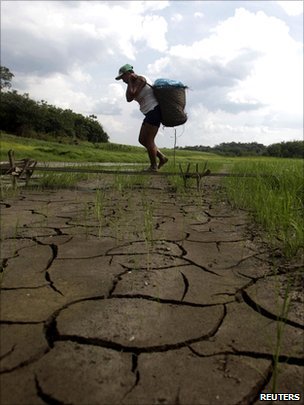 |
| Reviews and Templates for Expression We |
Amazon drought 'severe' in 2010, raising warming fears
Last year's drought in the Amazon raises concerns about the region's capacity to continue absorbing carbon dioxide, scientists say.
 Researchers report in the journal Science that the 2010 drought was more widespread than in 2005 - the last big one - with more trees probably lost.
Researchers report in the journal Science that the 2010 drought was more widespread than in 2005 - the last big one - with more trees probably lost.
The 2005 drought had been termed a "one in a century" event.
In drought years, the Amazon region changes from being a net absorber of carbon dioxide into a net emitter.
The scientists, from the UK and Brazil, suggest this is further evidence of the Amazon's vulnerability to rising global temperatures.
They also suggest the days of the Amazon forest curbing the impact of rising greenhouse gas emissions may be coming to an end.
The 2010 drought saw the Amazon River at its lowest levels for half a century, with several tributaries completely dry and more than 20 municipalities declaring a state of emergency.
Research leader Simon Lewis, from the University of Leeds, is the scientist who gained an apology from the Sunday Times newspaper last year over the so-called "AmazonGate" affair.
"It's difficult to detect patterns from just two observed droughts, but to have them close together is concerning," he told BBC News.
Both droughts were associated with unusually warm seas in the Atlantic Ocean off the Brazilian coast.
"If that turns out to be driven by escalating greenhouse gas concentrations in the atmosphere, it could imply that we'll see more drought years in the near future," said Dr Lewis.
"If events like this do happen more often, the Amazon rainforest would reach a point where it shifts from being a valuable carbon sink slowing climate change to a major source of greenhouse gases."
Some computer models of climate change - in particular, the one developed at the UK's Hadley Centre - project more droughts across the region as the planet warms, and a diminishing capacity to absorb CO2.
There are several ways in which warming can turn greenhouse gas-absorbing forests into emitters.
In the Amazon, the principal mechanism is simply that trees die and then rot; in addition, those trees are then not available to absorb CO2 from the air.
Eye in the skyFor this research, scientists used data from the Tropical Rainfall Measuring Mission (TRMM), a US/Japanese satellite that monitors rainfall in a belt extending either side of the Equator.
Its observation showed that whereas the 2005 drought covered an area of nearly two million sq km, in 2010 it stretched for three million sq km.

Data came from the US/Japanese TRMM satellite, a window on tropical rainfall
Following the 2005 drought, scientists were able to study the impact on trees and work out the relationship between the rainfall loss and the release of carbon.
In an average year, the basin absorbs about 1.5 billion tonnes of CO2 from the atmosphere.
By contrast, the impact of the 2005 drought, spread over a number of years, was calculated as a release of five billion tonnes.
The new paper calculates the figure for 2010 as about eight billion tonnes, as much as the annual emissions of China and Russia combined; but this, the researchers acknowledge, is a first estimate.
"It could be that many of the susceptible trees were killed off in 2005, which would reduce the number killed last year," said Paulo Brando from the Amazon Institute of Environmental Research (IPAM) in Belem, Brazil.
"On the other hand, the first drought may have weakened a large number of trees, so increasing the number dying in the 2010 dry season."
Leeds University is part of a research group that maintains about 130 land stations across the Amazon region.
If funds are forthcoming, the team will visit them all in the coming months to gather first-hand data on tree deaths.
This should provide for a more accurate estimate of the 2010 drought's contribution to global emissions.
Closing the gateThe likely fate of the Amazon under climate change came under focus early last year when, as one of a series of attacks on the Intergovernmental Panel on Climate Change (IPCC), the Sunday Times newspaper accused the panel of having included an unsubstantiated claim that up to 40% of the forest could be affected by climate change in future.

Some Amazon rivers saw their lowest level for decades in 2010
It used quotes from Dr Lewis in support of its claim.
In fact, Dr Lewis was concerned about the region's vulnerability and had sent the newspaper a sheaf of scientific papers to back the case.
He told the newspaper that the IPCC had sourced its statement to a report from environmental group WWF, when it should have referenced the scientific papers WWF had used in its report.
"In fact, the IPCC's Amazon statement is supported by peer-reviewed scientific evidence," the Sunday Times acknowledged in its apology.
Commenting on that so-called "AmazonGate" episode from the perspective of the new research, Dr Lewis noted:
"The notion that the Amazon is potentially very vulnerable to droughts linked to climate change was reasonable and defensible at the time, and is consistent with the new findings.
"If greenhouse gas emissions contribute to Amazon droughts that in turn cause forests to release carbon, this feedback loop would be extremely concerning.
"Put more starkly, current emissions pathways risk playing Russian roulette with the world's largest rainforest."
http://www.bbc.co.uk/news/science-environment-12356835
|
|
|
|
Copyright 2011 Energy and Technical Services Ltd. All Rights Reserved. Energyts.com |